#realHum
Text

Deercember Day Thirty: Megaloceros giganteus | Great Feast
Megaloceros giganteus, also known as the Irish elk, giant deer, or Irish deer, is an extinct species and is one of the largest deer that ever lived. Its range extended across Eurasia during the Pleistocene, from Ireland (where it is known from abundant remains found in bogs) to Lake Baikal in Siberia. The most recent remains of the species have been radiocarbon dated to about 7,700 years ago in western Russia. Its antlers, which can span 3.5 meters (11 ft) across, are the largest known of any deer. It is not closely related to either living species called the elk (Alces alces or Cervus canadensis), with it being widely agreed that its closest living relatives are fallow deer (Dama spp.). A handful of Irish elk depictions are known from the art of the Upper Paleolithic in Europe. However, these are much less abundant than the common red deer and reindeer depictions. The bones of the Irish elk are uncommon in localities where they are found, and only a handful of examples of human interaction are known. More information here.
References: Deer, Megaloceros Design 1, Megaloceros Design 2, Cat, Smilodon Design, Style Suggestion.
#Extinct representative for one of my three “free” days#I'll give myself a little treat and do something easy#I said#cave art should be fast#well to be fair it was fast#but boy this is challenging to do well#so I said fuck it and did it mediocre LOL#didn't even dabble into the wild proportions of Pleistocene art#idek if I could tbh#did learn some stuff tho so that was cool#SECOND-TO-LAST DAY#btw these species did not coexist so some significant liberties were taken for sure#I just needed two well-researched species for the period and this is how things went#Deercember#realHum#Art#Drawing#deer#deer art#paleoart?#Megaloceros giganteus#Irish elk#giant deer#Irish deer#Smilodon fatalis#saber-toothed cat#saber-toothed tiger
20 notes
·
View notes
Text

Deercember Day One: European Fallow Deer | Roses and Posies
The European fallow deer (Dama dama), also known as the common fallow or simply fallow, is historically native to Turkey and potentially the Italian Peninsula, Balkan Peninsula, and the island of Rhodes. Prehistorically, the species was native to a wider range of Europe, and has since been reintroduced, as well as introduced to many non-native regions. Prior to the rut, stags strengthen their neck and shoulder muscles—as well as leave communicative markings—by rubbing their antlers against trees, foliage, and even the ground, sometimes coming away with "crowns". European fallow deer are widely agreed to be the closest living relative of Megaloceros giganteus, or the "Irish elk". More information here.
References: Deer, Background, Wild Rose, Posy.
#I don't do backgrounds (as you can see) but I wanted to try#but by the time I got to it was pretty tired and knew since I have to finish today my only hope was purely using texture brushes#idk how people do it#Deercember#realHum#Art#Drawing#deer#deer art#European fallow deer#fallow deer#Dama dama
16 notes
·
View notes
Text

Deercember Day Twenty: Huemul | Windswept Pines
The huemul (Hippocamelus bisulcus)—also known as the south Andean deer, southern guemal, south Andean huemul, southern huemul, or Chilean huemul or güemul—is an endangered species of deer native to the mountains of Argentina and Chile. Along with the taruca, it is one of the two deer in the Hippocamelus genus and ranges across the high mountainsides and cold valleys of the Andes. While it was previously found over much of southwestern South America, the current status of the huemul is critical. Numbers in Argentina were estimated at 350–600, in fragmented groups, as of 2005. The huemul is part of Chile's national coat of arms and is a National Natural Monument since 2006. The huemul is well-adapted to broken, difficult terrain with a stocky build and short legs. Males also have a distinctive black "face mask", which curves into an elongated heart-shape surrounding a forehead of the principal brown colour. Unusually for a dimorphic ungulate, research has shown huemul will congregate in mixed-sex groups, and the length of time spent inter-mixing increases with group size. The farther the animals are from rocky slopes the larger the size of observed groups, suggesting predation rates are lowest on slopes and greatest in open areas such as valley bottoms. This deer ranges across a variety of often difficult habitats. It usually prefers open periglacial scrubland, low bluffs, and other rocky areas, as well as upland forests and forest-borders. One study of coastal fjord populations found males and juveniles preferred periglacial grassland; females were mainly found on bluffs, and fawns exclusively so. More information here.
References: Deer, Trees and Background.
#went with more generalized conifers than pines‚ though I choose to believe I'm simply using “pines” as a colloquialism#those trees in the background don't natively exist in South America but let's pretend#happiest I've been with a tree in my life so far though! particularly the top part#bottom/front tree less so but didn't have a redo in me#it's 3:40a at the time or writing and I've got to be up by 11a#similar to yesterday#RIP Hum but literally#Deercember#realHum#Art#Drawing#deer#deer art#huemul#south Andean deer#southern guemal#south Andean huemul#southern huemul#Chilean huemul#Hippocamelus bisulcus
10 notes
·
View notes
Text

Columbian black-tailed deer (Odocoileus hemionus columbianus).
#happy little bonus because despite the bioluminescent mushrooms being an excellent solution to natural will-o'-wisp#I feel I may actually prefer the piece without them#but gotta keep the theme#realHum#Art#Drawing#deer#deer art#Columbian black-tailed deer#Columbian blacktail deer#Columbian blacktail#black-tailed deer#blacktail deer#blacktail#Odocoileus hemionus columbianus
9 notes
·
View notes
Text
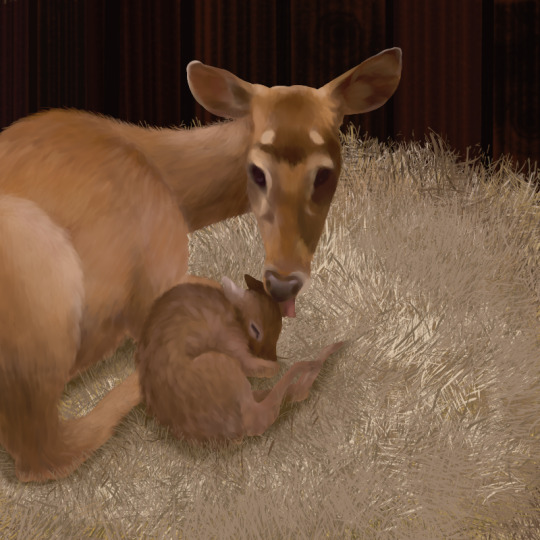
Deercember Day Ten: Burmese Eld's Deer | Guardian
The Burmese Eld's deer (Panolia eldii thamin, or Rucervus eldii thamin), also known as the thamin or Burmese brow-antlered deer, is an endangered subspecies of deer endemic to Myanmar and westernmost Thailand. Subject to indiscriminate hunting in the past—until the ownership of guns was controlled after the 1960s—the thamin now has a population of about 1,000. Initially, the Smithsonian National Zoo acquired a few thamin for observations and subsequently shifted a few to its Conservation and Research Center at Front Royal, Virginia for biological study. For a cross–check of the biological studies done at the research center, the Smithsonian Institution selected the Chatthin Wildlife Sanctuary, a protected park. Special studies on the thamin deer were conducted by the conservation scientists headed by Christen Wemmer of the Smithsonian. They gathered details on the biology and survival of the species by duly correlating with the changes that occurred in the ecology of the region of the Chatthin Wildlife Sanctuary. Under the research project study, the ecology of thamin and a series of training courses in biodiversity were organised. In 1850, John Edward Gray proposed the name Panolia eldii for the species. Despite now being classified under Rucervus in most modern taxonomic systems, it has recently been proposed that it should be moved back to the genus Panolia on the basis of recent genetic findings that place it closer to Père David's deer than to other members of the genus Rucervus. More information about all Eld's subspecies here.
Reference: Deer and Background.
#this is my first lineless piece#as well as first in the series that I actually painted#typically I don't have the time or energy‚ but I actually did this one in about 4.5 hours#which is faster than I have been‚ as the others have been usually 6 - 7 hours#Eld's deer have a prominent spot in my heart and I had to do them justice#this theme in particular I had very strong feelings about.#Deercember#realHum#Art#Drawing#deer#deer art#Eld's deer#Burmese Eld's deer#thamin#brow-antlered deer#Burmese brow-antlered deer#Panolia eldii#Panolia eldii thamin#Rucervus eldii#Rucervus eldii thamin
9 notes
·
View notes
Text

Deercember Day Fourteen: Barasingha Deer | Wild Strawberries
The barasingha (Rucervus duvaucelii), sometimes barasinghe, also known as the swamp deer, is a species distributed in the Indian subcontinent. Populations in northern and central India are fragmented, and two isolated populations occur in southwestern Nepal. It has been extirpated in Pakistan and Bangladesh, and its presence is uncertain in Bhutan. The scientific binomial name commemorates the French naturalist Alfred Duvaucel. The swamp deer differs from all other Indian deer species in that the antlers carry more than three tines. Because of this distinctive characteristic, it is designated bārah-singgā, meaning "twelve-horned" in Hindi. Mature stags usually have ten to fourteen tines, and some have been known to have up to twenty. In central India, the herds number on average about eight to twenty individuals, with large herds of up to sixty, comprised of twice as many females as males. During the rut, they form large herds of adults. The breeding season lasts from September to April, and the single-calf births occur after a gestation of 240 – 250 days from August to November, with the peak in September and October in Kanha National Park. Compared to other deer species, barasingha are more relaxed when it comes to guarding. They have fewer sentries and they spend most of their time grazing, unlike deer species like chital or sambar. More information here.
Reference: Deer and Background.
#week two complete!#absolute record time on this bad boy with a total editing time of one hour and thirty-three minutes#100% texture brushes aside from the deer who is a watercolour brush on top of an ink brush base#still only semi-feeling it today‚ so decided to go quick and dirty with a semi-watercolour semi-something-else vibe#the fancy colours were a happy colour-picking accident that I went with#despite my lack of muse‚ barasingha are one of my favourites‚ and my OOC was actually based on one prior to being a unicorn‚ many years ago#I think this is the earliest I've finished so far and I'm so excited to get some gosh darn sleep at a potentially even decent hour#Deercember#realHum#Art#Drawing#deer#deer art#barasingha#barasinghe#swamp deer#Rucervus duvaucelii
8 notes
·
View notes
Text

Deercember Day Six: Mountain Reindeer | Baskets and Bouquets
The mountain reindeer (Rangifer tarandus tarandus)—also called the Norwegian reindeer, northern reindeer, common reindeer, or mountain caribou—is a medium to large subspecies of the reindeer who is native to the western Scandinavian Peninsula, particularly Norway. Reindeer/caribou on the whole have what is called a "circumpolar distribution", which is a range that occurs over a wide span of longitudes but only a narrow band of latitudes, and they call the Arctic, subarctic, tundra, boreal, and mountainous regions of Northern Europe, Siberia, and North America home. Reindeer hooves are somewhat soft during warmer months, but in the Winter, their hooves become hard and sharp for breaking through the ice to forage vegetation, particularly the aptly-named reindeer lichen (Cladonia rangiferina). Reindeer eyes also adapt to the different light levels across the changing of the seasons by changing colour; their tapetum—the part of the eye behind the iris—changes from gold in the Summer to purple-blue in the Winter. This change is not directly visible externally, but allows the animal to see optimally across the dramatic day and night lengths of the polar region. Reindeer are the only successfully semi-domesticated deer on a large scale in the world, and both wild and domestic reindeer have been an important source of food, clothing, and shelter for Arctic people throughout history and are still herded and hunted today. More information here about mountain reindeer, and here about reindeer/caribou.
References: Deer, Basket, Reindeer Lichen.
#still haven't entirely recovered from the burn-out yesterday#I proved my skill with the red deer on the 4th#now I prove my stamina#hopefully#Deercember#realHum#Art#Drawing#deer#deer art#mountain reindeer#Norwegian reindeer#northern reindeer#common reindeer#mountain caribou#Rangifer tarandus tarandus
8 notes
·
View notes
Text
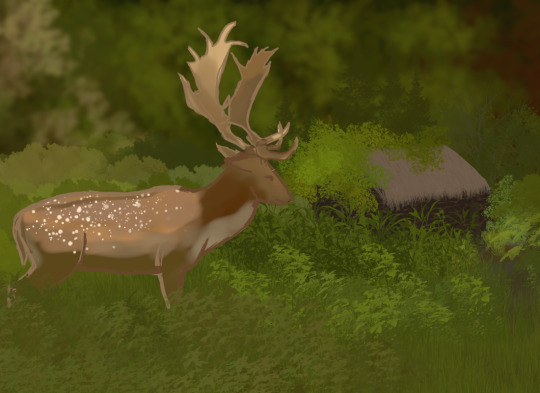
Deercember Day Five: Persian Fallow Deer | Apothecary
The Persian fallow deer (Dama mesopotamica) was once native to all of the Middle East, but currently only lives in Iran and Palestine/Israel, the latter of which it was reintroduced to. It has been listed as endangered on the IUCN Red List since 2008. After a captive breeding program, the population has rebounded from only a handful of deer in the 1960s to over a thousand individuals. The Persian fallow deer is only morphologically distinguishable from other fallow deer by having antlers that are less palmated. The deer prefers woodlands of tamarisk, oak and pistachio, and avoids roads even with little traffic, which limits its spread and movement. More information here.
References: Deer and Background, Stone Cottage.
#between taking care of my gecko who is on end-of-life care‚ working‚ not getting enough sleep last night (to finish yesterday's drawing)‚#having grand plans for the background of this that I spent about three hours on but none of which worked out‚ and probably other stuff‚#I'm just really tired#I'm hoping I have the vigour to revisit this and do the species the justice it deserves#but for now‚ I must rest#Remember‚ if you're not having fun‚ it's okay to take a break#Deercember#realHum#Art#Drawing#deer#deer art#Persian fallow deer#Dama mesopotamica
8 notes
·
View notes
Text
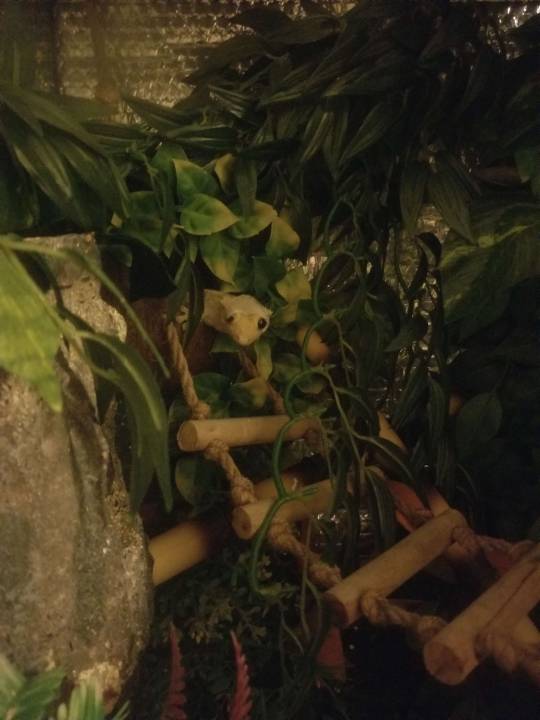


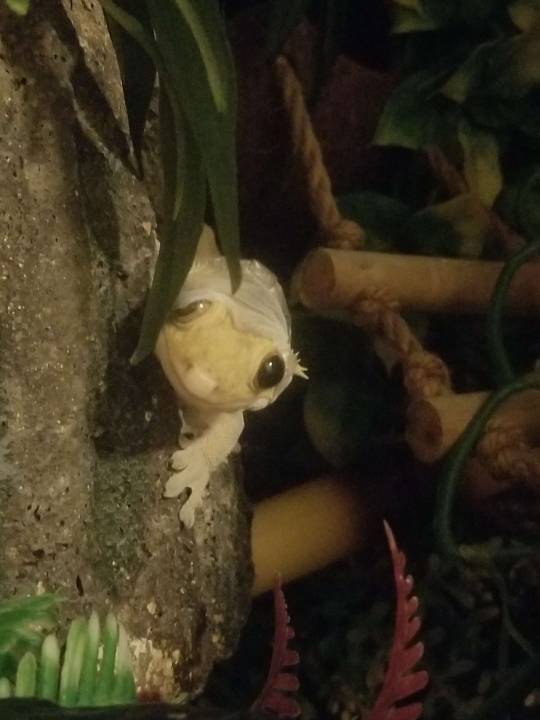
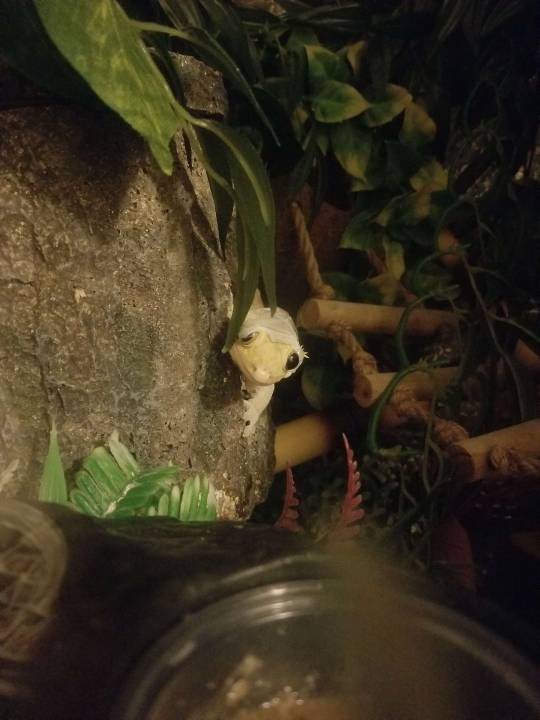

New year, new skin!
#realHum#my pets#Beep#New Caledonian eyelash crested gecko#crested gecko#cresie#Correlophus ciliatus#lizard#reptiblr#reptile#herp
7 notes
·
View notes
Text

Deercember Day Nineteen: Taruca Deer | Dusting of Snow
The taruca (Hippocamelus antisensis)—also known as the Peruvian guemal, north Andean deer, north Andean huemul, northern huemul, or northern guemal—is a mid-sized deer species that inhabits the high regions of the Andes mountains in South America. Tarucas are found only in the Andes mountains, from central Peru, through Bolivia and extreme north-eastern Chile, and into northern Argentina. The common name taruca means "deer" in both the Quechua and Aymara languages, though these are not interrelated. Tarucas are mainly found on rocky slopes, queñual forests, and puna grasslands near glacial lakes at high-altitude mountain terrains. Despite living in grasslands, the taruca feeds mainly on the local bushes, shrubs, and herbs for much of the year, but supplements this diet with grasses during the rainy season. Unlike other South American deer, except for the closely-related huemul, the antlers consist of just two tines which branch from the base, and with the posterior tine being the larger. Males also possess canine teeth in their upper jaw, which females usually, but not always, lack. More information here.
References: Deer and Grass, Mountains.
#I'm not sure about the snow layer but THE THEME#messy mountains but they are surprisingly difficult#I consulted our expert Bob Ross but unfortunately the traditional to digital skill did not directly translate#I will have to revisit them conceptually one day#Deercember#realHum#Art#Drawing#deer#deer art#taruca#Peruvian guemal#north Andean deer#north Andean huemul#northern huemul#northern guemal#Hippocamelus antisensis
7 notes
·
View notes
Text
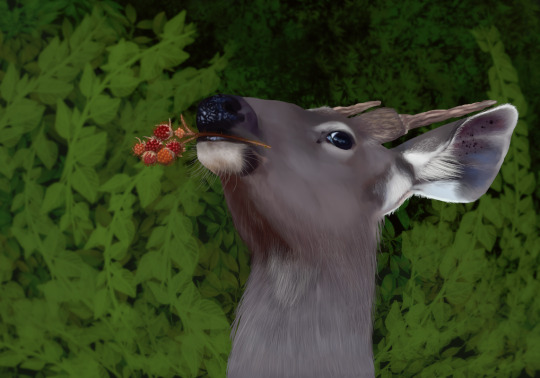
Deercember Day Twelve: Sambar Deer | Brambles and Berries
The sambar (Rusa unicolor) is a large deer native to the Indian subcontinent, South China, and Southeast Asia that is listed as a vulnerable species on the IUCN Red List since 2008. Populations have declined substantially due to severe hunting, local insurgency, and industrial exploitation of habitat. Analysis shows that the closest living relative of the sambar is most likely the Javan rusa of Indonesia; this is supported by reports that sambar can still interbreed to produce fertile hybrids with this species. Sambar use their height to their advantage in regards to their diet, as unlike smaller deer such as chital who share their range, sambar are browsers who often take advantage of fruiting seasons to eat the fruit which smaller species cannot access. Adult males and pregnant or lactating females possess an unusual hairless, blood-red spot located about halfway down the underside of their throats, referred to as a "sore spot". This sometimes oozes a white liquid, and is apparently glandular in nature, typically being active during the rut. More information here.
References: Deer, Wineberries.
#this one is either my new favourite or tied with the red deer#0 brushes used for his fur or the berries#just the background#apparently I've just missed my typical painting style or something#I'll take it lol#as before I ensured the berry species coincides with the range of the deer#this is Rubus phoenicolasius‚ the Japanese wineberry‚ wine raspberry‚ wineberry‚ or dewberry#Deercember#realHum#Art#Drawing#deer#deer art#sambar#sambar deer#Rusa unicolor#Rubus phoenicolasius
7 notes
·
View notes
Text
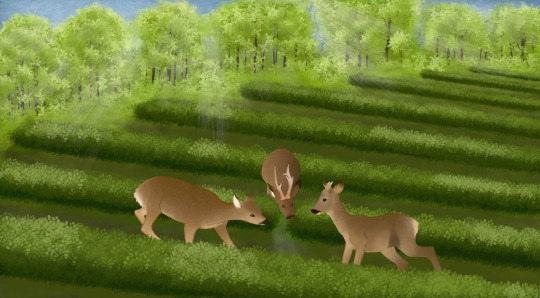
Deercember Day Two: European Roe Deer | Tea Party
The European roe deer (Capreolus capreolus), also known as the Western roe or simply roe, is widespread in Europe, ranging from Scotland to the Caucasus, the Mediterranean to Scandinavia, and as far East as Iran. Cultivated tea plantations (Camellia sinensis) are considered a deer-resistant plant, though their tender shoots from which more delicate green teas are harvested may be particularly alluring to the roe, who typically favour new growth, particularly on days after heavy rain. Roe deer are most closely related to water deer, and surprisingly, the species in this subfamily (Capreolini) are most closely related to moose and reindeer. More information here.
References: Deer, Tea.
#started with the background this time and I think it made a massive difference#though I also ran out of juice doing the deer themselves#doubt I'll keep up with backgrounds as far as I go‚ but this particular image came to me and needed a background to be expressed properly#Deercember#realHum#Art#Drawing#deer#deer art#European roe deer#Western roe deer#roe deer#Capreolus capreolus
7 notes
·
View notes
Text
A leopard gecko who I've had for sixteen years is dying and the surgery that was supposed to remove the mass only discovered that it is irremovable and spreading, and now she has to deal with both the abdominal mass and having stitches which she very likely will not live long enough to heal from. I am very sad.
#realHum#I had a panic attack so severe that my SO's dog left his constant post by the front door to come check on me
9 notes
·
View notes
Text
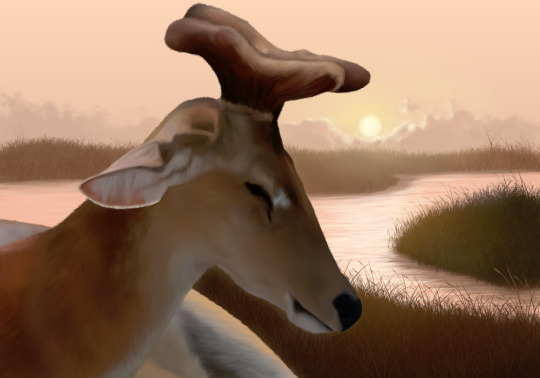
Deercember Day Thirty-One: Sangai | New Beginnings
The sangai (Panolia eldii eldii according to current genetic evidence, though Rucervus eldii eldii according to most scientific literature) is an endemic and endangered subspecies of Eld's deer found only in Manipur, India. It is also the state animal of Manipur. Its common English name is Manipur brow-antlered deer or Manipur Eld's deer, though it is also known as the dancing deer due to a particular behaviour: it is believed that the name sangai (sa "animal" and ngai "in awaiting") was coined from its peculiar posture and behaviour while running; by nature, the deer—particularly the males, even when running for its life—stops occasionally and looks back as if waiting for someone.
Its original natural habitat is the floating marshy grasslands of the Keibul Lamjao National Park, located in the southern parts of Loktak Lake, which is the largest freshwater lake in South Asia. The park covers an area of 40 km² (15.44 mi²) and the home range of the deer in the park is confined to 15 – 20 km² (5.79 - 7.72 mi²). Phumdi is the most important and unique part of the habitat; it is the floating mass of vegetation formed by the accumulation of organic debris and biomass with soil, with thickness varying from few centimeters to two meters. The humus of phumdi is black in colour and very porous and spongy. It floats with 80% of its mass submerged in an annual cycle of rising and falling on Loktak Lake, though this has been disrupted by a hydroelectric dam resulting in the deterioration of the phumdi.
The sangai was believed to be almost extinct by 1950. However, in 1953, six heads of the sangai were found in its natural habitat. Since then, the Manipur state government has taken serious and positive measures toward its protection. The number of sangai listed in the Red Data Book was only 14 in 1975. Despite this, its number has since increased to 204 in 2013, and to 260 in March of 2016. The genetic bottle-necking of this near-extinction event may yet have catastrophic effects on the subspecies, with concerning evidence being found in instances such as albinism despite the small population size.
Culturally, the sangai finds itself embedded deep into the legends and folklore of the Manipuri people. Based on a popular folk legend, the sangai is interpreted as the binding soul between humans and nature. The slaying of the sangai, an unpardonable sin, is conceived as the forceful separation of the harmonious relationship between humans and nature. When humans love and respect the sangai, it is respecting nature. In the sangai, therefore, humans find a way of expressing their love for nature. More information here.
References: Deer*, Background.
* If you recognize the source for the sangai photograph, please let me know. I have several saved, this one from October of 2021, and can no longer find a source.
#Deercember final day complete#genuinely shocked I drew 31 days straight#I am so tired#both from today as it is after ten in the morning#and from the month as a whole#but I am also so fulfilled#third day of dealer's choice you know I had to draw my own OC#but at least had the decency to wait until the end#it's been a wild ride#happy to have done it#Deercember#realHum#Art#Drawing#deer#deer art#stone#The Stone Balancer#sangai#Manipur Eld's deer#Manipur brow-antlered deer#Eld's deer#brow-antlered deer#Panolia eldii eldii#Panolia eldii#Rucervus eldii eldii#Rucervus eldii
6 notes
·
View notes
Text
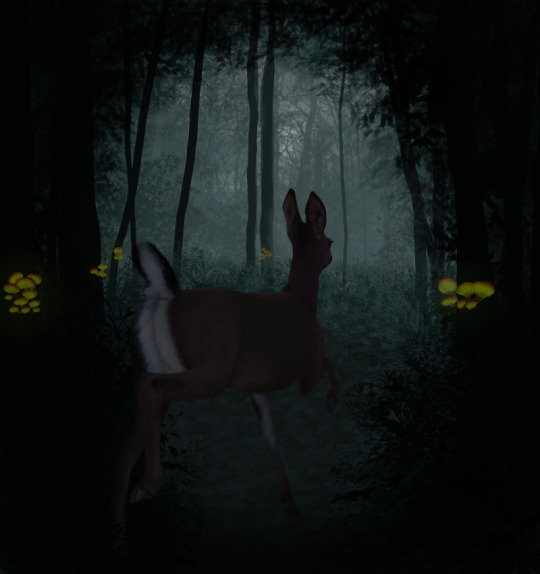
Deercember Day Twenty-Seven: Columbian Black-tailed Deer | Will-o'-wisp
The Columbian black-tailed deer or blacktail (Odocoileus hemionus columbianus) is found in western North America, from Northern California into the Pacific Northwest of the United States and coastal British Columbia in Canada. East of the Cascade and Sierra Nevada Ranges in Oregon and California, black-tailed deer are replaced by other mule deer which have a different tail pattern. They have sometimes been treated as a species, but virtually all recent authorities maintain they are subspecies of the mule deer (Odocoileus hemionus). Strictly speaking, the black-tailed deer group consists of two subspecies, as it also includes Odocoileus hemionus sitkensis (the Sitka deer). Despite this, the mtDNA of the white-tailed deer and mule deer are similar, but differ from that of the black-tailed deer. This may be the result of introgression, although hybrids between the mule deer and white-tailed deer are rare in the wild (apparently more common in West Texas), and the hybrid survival rate is low even in captivity. These two subspecies thrive on the edge of the forest, as the dark forest lacks the underbrush and grasslands the deer prefer as food, and completely open areas lack the hiding spots and cover they prefer for harsh weather. One of the plants that black-tailed deer browse is western poison oak, despite its irritant content. During the winter and early spring, they feed on Douglas fir, western red cedar, red huckleberry, salal, deer fern, and lichens growing on trees. Late spring to fall, they consume grasses, blackberries, apples, fireweed, pearly everlasting, forbs, salmonberry, salal, and maple. More information here.
References: Deer, Background, Mushrooms 1, Mushrooms 2.
#this went better than I ever could have hoped or expected and may be my new favourite#this one is special to me because this subspecies of mule deer is exactly the same#as lives on the property where Stan and I will be building our home#and is one of only a handful of deer who I've had the honour of seeing in person#the mushroom species is the western jack-o'-lantern mushroom (Omphalotus olivascens) native to California and Mexico#shoutout to my bestie Wind for the amazing suggestion for a natural will-o'-wisp#I am‚ quite frankly‚ blown away with myself today#Deercember#realHum#Art#Drawing#deer#deer art#Columbian black-tailed deer#Columbian blacktail deer#Columbian blacktail#black-tailed deer#blacktail deer#blacktail#Odocoileus hemionus columbianus
5 notes
·
View notes
Text

Deercember Day Seventeen: Yucatán Brown Brocket | Standing Stones
The Yucatán brown brocket (Odocoileus pandora) is a small species of deer native to Central America, specifically the Yucatán Peninsula of Mexico, Belize, and Guatemala. While it is found in humid tropical forests like most other brocket deer, the Yucatán brown brocket also ranges across arid, relatively open habitats. It had been previously treated as a disjunct subspecies of the gray brocket (Mazama gouazoubira) or a subspecies of the red brocket (Mazama americana). In 2021, according to the American Society of Mammalogists, the species was made unique among brockets as, unlike the other nine species which are all still classified under the genus Mazama, the Yucatán brown brocket is now classified under the genus Odocoileus alongside mule deer and white-tailed deer. Among other features, the Yucatán brown brocket differs from both the red brocket and the gray brocket in the shape and measurements of the skull and antlers. It also differs from the Central American red brocket (Mazama temama)—which is locally sympatric with the Yucatán brown brocket—in its gray-brown, rather than overall reddish, colour. More information here.
References: Deer, Chichen Itza Pyramid and Background, Sunset Background.
#colour-shifted my references to match the ambient lighting for the first time and I think it went well!#I believe this is my first ambitious background so far which has gone essentially as planned#feels very nice#happy to get to use the leaf-covered ground again too#Deercember#realHum#Art#Drawing#deer#deer art#Yucatán brown brocket#Odocoileus pandora
5 notes
·
View notes